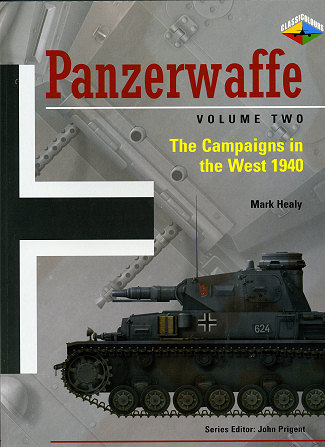 This
second volume starts with the planning, preparation and condition of the
panzerwaffe prior to the invasion of France and the Low Countries. There were
some lessons learned during the Polish campaigns, but much of this did not seem
to trickle up to the general staff, who still saw tanks as little more than an
adjunct to the infantry.
This
second volume starts with the planning, preparation and condition of the
panzerwaffe prior to the invasion of France and the Low Countries. There were
some lessons learned during the Polish campaigns, but much of this did not seem
to trickle up to the general staff, who still saw tanks as little more than an
adjunct to the infantry.
Since the Poles had little in the way of powerful tanks, the
German army still did not realize how insufficient their tanks were in
comparison to those of the British and the French. However, the Germans had
superior tactics and their tanks had qualities that were able to overcome many
of the deficiencies as you'll see when you read the book.
This is as much a story of von Manhiem and Guderian as it is
of anything else. The German High Command was stuck back in the first war,
though not as much as the French. Their stubbornness and lack of trust of new
ideas is as much of the story of the May 1940 invasion as is the operation of
tanks.
Few also realize that the French attack was an all or nothing
sort of deal. The near entirety of the German army was committed to the assault.
Many generals were anticipating a blood bath and then a reversion to trench
warfare. They were not at all optimistic and at one time, were even considering
a coup against Hitler to stop the invasion.
However, von Manheim and Guderian were able to convince
Hitler that a fast strike by tanks leading the way through the 'impassable'
Ardennes was the best way to break though the French lines. And so it was done.
Things did not go very smoothly as there were few bridges
across the Meuse and the bottlenecks through the Ardennes were significant. The
time table was thrown off and even though there were break-throughs, things were
not precisely according to plans. Despite this, the Allies had thought the main
thrust would be through Belgium as in WWI and the Allies were convinced this
would be the case this time. As a result, all their manpower and materiel was
concentrated there. The Germans put through a lesser force, hoping to draw the
Allies away from the main assault and in this they were most successful.
Despite having superior tanks in terms of firepower and
armor, the poor tactics of the Allies assured their defeat. Though out-gunned
and out-armored, German tanks and infantry were able to move much quicker, were
better coordinated and able to find the weak spots in Allied armor.
And so it went. There is much more in this book that covers
the reticence of the German Generals to allow the panzers to operate freely and
what Guiderian did despite them. A gripping tale of warfare and all of the
things that go right and the many more that go wrong!
In line with the aviation titles from Classic Colors, there
are a considerable number of superb period photographs, some equally nice color
profiles and a well written historical background. I found it to be a fascinating read and one from which I
learned a great deal. I'm sure that there are some surprises in store for you as
well. It is a book that is exceptional and I think that
you will agree.
March 2008
Review book courtesy of
Casemate Publishing, where you can order your copy of this and many other superb books.
If you would like your product reviewed fairly and quickly, please contact
me or see other details in the Note to
Contributors.
 This
second volume starts with the planning, preparation and condition of the
panzerwaffe prior to the invasion of France and the Low Countries. There were
some lessons learned during the Polish campaigns, but much of this did not seem
to trickle up to the general staff, who still saw tanks as little more than an
adjunct to the infantry.
This
second volume starts with the planning, preparation and condition of the
panzerwaffe prior to the invasion of France and the Low Countries. There were
some lessons learned during the Polish campaigns, but much of this did not seem
to trickle up to the general staff, who still saw tanks as little more than an
adjunct to the infantry.